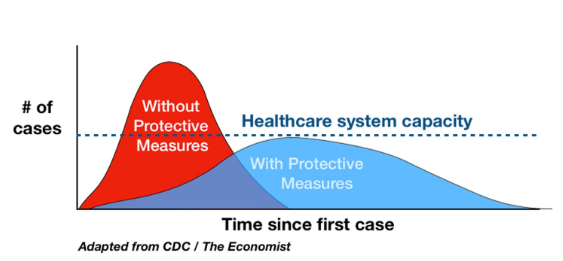How the government should have flattened the curve

A graph shows how protective measures can reduce the number of cases, therefore not overwhelming the healthcare system.
The phrase “flatten the curve” is all over the media. In theory, it’s a simple concept: if everyone cuts contact, COVID-19 cases will flatten out and slowly fade away without a massive death toll. Simple enough…right?
No. You’ve forgotten how dim-witted people are. It seems that a human’s natural instinct is to want to do what they cannot or should not do. People refuse to follow simple instructions even when it comes to a matter as dire as life and death. This has been evident long before the virus started, solely by the fact that we even need law enforcement to function as a society. So why does the government think a few recommended precautionary measures will stop a pandemic? Because it won’t.
As of March 31, the US has over 160,000 COVID-19 cases, topping the next highest country, Italy, by nearly 60,000 cases. Compared to countries such as South Korea and China, the United States lags behind in its efforts to limit the spread of the virus. Science Mag points out a flaw in transmitting China’s aggressive methods over to other countries such as the US: “The question now is whether the world can take lessons from China’s apparent success—and whether the massive lockdowns and electronic surveillance measures imposed by an authoritarian government would work in other countries.”
When the virus started in the US, it took six weeks for the federal government to react. Meanwhile, states imposed social distancing guidelines, closed schools, and encouraged businesses to have employees work from home. In response, people flooded outdoor spaces such as beaches and national parks and continued to meet with friends, eliminating the point of imposing these guidelines.
Following this blatant disregard for the rules, Oregon and 25 other states issued, in some form, a “stay at home” or “shelter in place” executive order. People may no longer leave their houses except for essentials such as groceries, medications, or for limited recreational outdoor activity. This executive order should have been imposed from the beginning.
Violating the executive order in Oregon (and most other states who have imposed similar statutes) is a Class C Misdemeanor, which is punishable by up to 30 days in jail and/or up to a $1,250 fine. With this incentive, the majority of Oregonians remain home, but the damage is already done. Yes, this measure will mitigate the number of new cases, but had it happened only two or three weeks earlier, it could have saved tens of thousands of lives nationwide.
At this point, there is little the US can do except enforce lockdowns. However, we can take this as a lesson to not wait until a virus is widespread to instate preventative measures. Another pandemic will inevitably hit the world in the hopefully distant future, and we need to be ready to take more harsh measures to flatten the curve. Shutting down sooner will not only save lives, but decrease the total time needed to stay in quarantine, resulting in lower rates of unemployment, a faster economic rebound, and less mental health issues due to long term isolation.

Natalie Foote is a sophomore at Beaverton High School who writes articles for The Hummer and helps manage its social media platforms. She enjoys running...


![Social Media has contributed to the rise of the incel movement [Photo via Wikimedia Commons under Creative Commons license].](https://beavertonhummer.com/wp-content/uploads/2025/02/Man_on_a_smartphone_Unsplash-600x400.jpg)

!["About The Weather" was released in 2023 as the first album by Portland emo band, Mauve. [About The Weather Album Cover]](https://beavertonhummer.com/wp-content/uploads/2024/05/AboutTheWeather.jpg)
